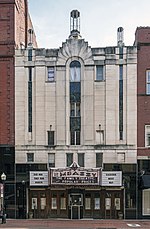Cumberland station (Western Maryland Railway)
1913 establishments in MarylandBuildings and structures in Cumberland, MarylandChesapeake and Ohio Canal National Historical ParkFormer Western Maryland Railway stationsFormer railway stations in Maryland ... and 6 more
Historic American Buildings Survey in MarylandNational Register of Historic Places in Allegany County, MarylandRailway stations in the United States opened in 1913Railway stations on the National Register of Historic Places in MarylandRepurposed railway stations in the United StatesTransportation buildings and structures in Allegany County, Maryland

Cumberland station is a historic railway station in Cumberland, Allegany County, Maryland. It was built in 1913 as a stop for the Western Maryland Railway (WM). The building was operated as a passenger station until the WM ended service in 1959, and it continued to be used by the railway until 1976. It was subsequently restored and currently serves as a museum and offices, as well as the operating base for a heritage railway.
Excerpt from the Wikipedia article Cumberland station (Western Maryland Railway) (License: CC BY-SA 3.0, Authors, Images).Cumberland station (Western Maryland Railway)
Canal Street, Cumberland
Geographical coordinates (GPS) Address Website Nearby Places Show on map
Geographical coordinates (GPS)
| Latitude | Longitude |
|---|---|
| N 39.649444444444 ° | E -78.763888888889 ° |
Address
Western Maryland Railway Station
Canal Street 13
21502 Cumberland
Maryland, United States
Open on Google Maps










